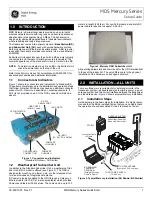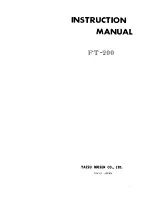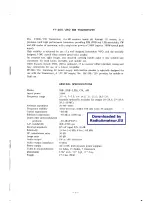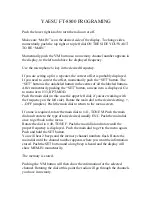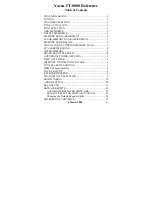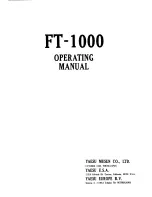
RT-9000C Hardware Supplement
Document No. 8121000602
Revision A (19 Mar 2007)
8-11
RT-9000 C
U106 and U104 amplify the signal output from the active VCO. The signal is then routed to power divider
T101, which sends half the applied power to PLL Control U101 as a feedback signal. The other half of the
signal power is sent to coaxial connector P3 located on the card edge as the First Local Oscillator output.
The feedback signal from the power divider enters PLL Control U101-pin 4 where it is internally routed to a
programmable frequency divider. The division ratio is directly related to the radio’s selected operating
frequency and is such that the divider output is approximately 100 kHz. The 10.7 MHz Reference signal
enters U101-pin 1 where it is internally routed to another frequency divider. This divider has a fixed division
ratio of 107 to produce an internal 100 kHz reference signal. An internal frequency/phase detector in U101
compares these two 100 kHz signals and determines if the VCO frequency is correct. The detector error
signal output appears on U101-pins 14 & 15 depending on whether the VCO frequency is above or below its
nominal frequency.
If the frequency is incorrect, the error output from U101 will cause Charge Pump U103 to change the voltage
applied to the VCO varactor diodes. This causes the VCO to change its frequency output until it is correct.
U101 also produces lock-detect status signals the BITE circuit (Built-In-Test-Equipment) uses to determine
Fault status.
Second Local Oscillator Signal Generation
The Second Local Oscillator (LO2) is similar to the First Local Oscillator except it operates at a fixed
frequency of 47.85 MHz. The single frequency-operating mode of LO2 requires only one voltage-controlled
oscillator (VCO). This VCO circuit is virtually identical to those used for the LO1 function.
U308 and U307 amplify the VCO signal output. The signal is then routed to power divider T301, which sends
half the applied power to PLL Control U301 as a feedback signal. The other signal half is sent to mixer X301
where the signal can be gated on and off by a control signal from noise blanker multivibrator U306. The
resulting signal is then routed to coaxial connector P4 located on the card edge as the Second Local
Oscillator output.
Feedback signal processing and use is the same as for the LO1 circuit except with the following differences.
PLL Control U301 controls LO2 but instead divides the feedback signal by a fixed ratio of 957 to produce
approximately 50 kHz. U301 accepts buffered 5 MHz Reference signal from the earlier reference section but
divides it by a fixed ratio of 100 to produce an internal 50 kHz reference signal. These signals are compared
and the resulting error signal is passed to charge pump U303 and causes it to lock the VCO at 47.850 MHz.
U301 also produces lock-detect status signals for BITE circuit Fault status determination.
Third Local Oscillator / BFO Signal Generation
The Third Local Oscillator (or BFO) signal is generated by U202 and U201. U202 accepts buffered 5 MHz
Reference signal from the earlier reference section, divides it by two, and produces the BFO CLOCK signal.
U201 further divides the 2.5 MHz BFO CLOCK signal down to 455 kHz and where it passes to Q202. The
signal is amplified by Q202 and sent to a low pass filter. It finally is band-pass filtered by FL201 and routed to
card edge connector P1-pin 2 as BFO OUT. U205-E provides a buffered sample of the BFO output for BITE
status monitoring.
Synthesizer Control
This synthesizer design replaces an earlier design and must be a form, fit, and function equivalent.
Accordingly, this newer design must be fully compatible with all earlier radio CPU assemblies. To achieve this
interchangeability this synthesizer design must translate all original commands to those required for this new
design. This task is handled by micro-controller U401. U401 is an 80C51 micro-controller family variation and
has internal program and data memory. A buffered output of the 25 MHz Reference signal is supplied to
U403, which divides it by two and sends to U401 as its clock signal.
Summary of Contents for RT-9000C
Page 3: ......
Page 4: ......
Page 5: ......
Page 6: ......
Page 7: ......
Page 8: ......
Page 9: ......
Page 10: ......
Page 11: ......
Page 12: ......
Page 13: ......
Page 14: ......
Page 15: ......
Page 16: ......
Page 17: ......
Page 18: ......
Page 19: ......
Page 20: ......
Page 21: ......
Page 22: ......
Page 23: ......
Page 24: ......
Page 25: ......
Page 26: ......
Page 27: ......
Page 28: ......
Page 29: ......
Page 30: ......
Page 31: ......
Page 32: ......
Page 33: ......
Page 34: ......
Page 35: ......
Page 36: ......
Page 38: ......
Page 39: ......
Page 40: ......
Page 41: ......
Page 42: ......
Page 43: ......
Page 44: ......
Page 45: ......
Page 46: ......
Page 47: ......
Page 48: ......
Page 49: ......
Page 50: ......
Page 51: ......
Page 52: ......
Page 53: ......
Page 54: ......
Page 55: ......
Page 56: ......
Page 57: ......
Page 58: ......
Page 59: ......
Page 60: ......
Page 61: ......
Page 62: ......
Page 63: ......
Page 64: ......
Page 65: ......
Page 66: ......
Page 67: ......
Page 68: ......
Page 69: ......
Page 70: ......
Page 71: ......
Page 72: ......
Page 73: ......
Page 74: ......
Page 75: ......
Page 76: ......
Page 77: ......
Page 78: ......
Page 79: ......
Page 80: ......
Page 81: ......
Page 82: ......
Page 83: ......
Page 84: ......
Page 85: ......
Page 86: ......
Page 87: ......
Page 88: ......
Page 89: ......
Page 90: ......
Page 91: ......
Page 92: ......
Page 93: ......
Page 94: ......
Page 95: ......
Page 96: ......
Page 97: ......
Page 98: ......
Page 99: ......
Page 100: ......
Page 101: ......
Page 102: ......
Page 103: ......
Page 104: ......
Page 105: ......
Page 106: ......
Page 107: ......
Page 108: ......
Page 109: ......
Page 110: ......
Page 111: ......
Page 112: ......
Page 113: ......
Page 114: ......
Page 115: ......
Page 116: ......
Page 117: ......
Page 118: ......
Page 119: ......
Page 120: ......
Page 121: ......
Page 122: ......
Page 123: ......
Page 124: ......
Page 125: ......
Page 126: ......
Page 127: ......
Page 128: ......
Page 129: ......
Page 130: ......
Page 131: ......
Page 132: ......
Page 133: ......
Page 134: ......
Page 135: ......
Page 136: ......
Page 137: ......
Page 138: ......
Page 139: ......
Page 140: ......
Page 141: ......
Page 142: ......
Page 143: ......
Page 144: ......
Page 145: ......
Page 146: ......
Page 147: ......
Page 148: ......
Page 149: ......
Page 150: ......
Page 151: ......
Page 152: ......
Page 153: ......
Page 154: ......
Page 155: ......
Page 156: ......
Page 157: ......
Page 158: ......
Page 159: ......
Page 160: ......
Page 161: ......
Page 162: ......
Page 163: ......
Page 164: ......
Page 165: ......
Page 166: ......
Page 167: ......
Page 168: ......
Page 169: ......
Page 170: ......
Page 171: ......
Page 172: ......
Page 173: ......
Page 174: ......
Page 175: ......
Page 176: ......
Page 177: ......
Page 178: ......
Page 179: ......
Page 180: ......
Page 181: ......
Page 182: ......
Page 183: ......
Page 184: ......
Page 185: ......
Page 186: ......
Page 187: ......
Page 188: ......
Page 189: ......
Page 190: ......
Page 191: ......
Page 192: ......
Page 193: ......
Page 194: ......
Page 195: ......
Page 196: ......
Page 197: ......
Page 198: ......
Page 199: ......
Page 200: ......
Page 201: ......
Page 202: ......
Page 203: ......
Page 204: ......
Page 205: ......
Page 206: ......
Page 207: ......
Page 208: ......
Page 209: ......
Page 210: ......
Page 211: ......
Page 212: ......
Page 213: ......
Page 214: ......
Page 215: ......
Page 216: ......
Page 217: ......
Page 218: ......
Page 219: ......
Page 220: ......
Page 221: ......
Page 222: ......
Page 223: ......
Page 224: ......
Page 381: ......
Page 382: ......
Page 383: ......
Page 384: ......
Page 385: ......
Page 386: ......
Page 387: ......
Page 388: ......
Page 389: ......
Page 390: ......
Page 391: ......
Page 392: ......
Page 393: ......































